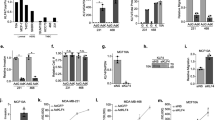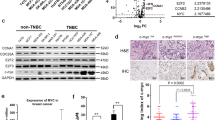Abstract
Gemcitabine is a nucleoside analog with clinical relevance in the treatment of several solid tumors, including breast carcinoma. In spite of its cytotoxic effect, clinical efficacy is impaired by the development of resistance. We performed gene expression analysis to shed light into the molecular mechanism of action of this drug in two breast cancer cell lines. Activation of genes related with cell cycle, cell growth and apoptosis (BNIP3L, CCNG2, DDIT4, TGFB2, TP53BP1, TP53INP1, and VEGF) was the main finding in the p53-wild type cell line MCF7, while the p53-non-functional cell line MDA-MB-231 was characterized by the regulation of NF-κB target genes (BIRC3, CXCL1/GRO1, IRAK2, TNF, TNFAIP and TRAF1). Genes consistently induced (ATF3, CCNG2, CDKN1A, EGR1, INSIG1, and MAF) or repressed (CCND1 and VGF) in both cell lines, were also found after gemcitabine treatment. In addition, MDA-MB-231 cells showed a higher basal and induced NF-κB transcriptional activity after treatment with gemcitabine. In comparison with gemcitabine, gene expression after 5-fluorouracil treatment showed essentially different profiles in both cell lines. This, in spite of using equitoxic concentrations producing similar effects on cell cycle. NF-κB transcriptional activity in MDA-MB-231 cells was dependent on IκB-alpha phosphorylation, as shown by functional experiments using the specific inhibitor BAY11-7082. Moreover, immunohistochemical analysis of clinical samples of breast carcinoma further validated the induction of NF-κB expression and IκB down-regulation upon neoadjuvant gemcitabine treatment. Thus, gene expression patterns, in vitro functional studies and analysis of tissue samples are in agreement with a role for NF-κB pathway in gemcitabine response. Together with the reported role for NF-κB in the induction of resistance to chemotherapy, our data gives support to clinical strategies combining gemcitabine with NF-κB inhibitors in breast cancer.
Similar content being viewed by others
References
Ramalingam S, Belani CP (2004) State-of-the-art chemotherapy for advanced non-small cell lung cancer. Semin Oncol 31:68–74
Hussain SA, James ND (2003) The systemic treatment of advanced and metastatic bladder cancer. Lancet Oncol 4(8):489–497
Heinemann V (2002) Gemcitabine in the treatment of advanced pancreatic cancer: a comparative analysis of randomized trials. Semin Oncol 29(6):9–16
Burris H 3rd, Moore M, Andersen J, Green M, Rothenberg M, Modiano M, Cripps M, Portenoy R, Storniolo A, Tarassoff P et al (1997) Improvements in survival and clinical benefit with gemcitabine as first- line therapy for patients with advanced pancreas cancer: a randomized trial. J Clin Oncol 15(6):2403–2413
Heinemann V (2005) Gemcitabine in metastatic breast cancer. Exp Rev Anticancer Ther 5(3):429–443
Plunkett W, Huang P, Searcy C, Gandhi V (1996) Gemcitabine: preclinical pharmacology and mechanisms of action. Semin Oncol 23(5 Suppl 10):3–15
Bergman AM, Eijk PP, Ruiz van Haperen VWT, Smid K, Veerman G, Hubeek I, van den IJssel P, Ylstra B, Peters GJ (2005) In vivo induction of resistance to gemcitabine results in increased expression of ribonucleotide reductase subunit M1 as the major determinant. Cancer Res 65(20):9510–9516
Shi Z, Azuma A, Sampath D, Li Y-X, Huang P, Plunkett W (2001) S-phase arrest by nucleoside analogues and abrogation of survival without cell cycle progression by 7-hydroxystaurosporine. Cancer Res 61(3):1065–1072
Ghosh S, May MJ, Kopp EB (1998) NF-kappa B and Rel proteins: evolutionarily conserved mediators of immune responses. Ann Rev Immunol 16(1):225–260
Dong G, Chen Z, Kato T, Van Waes C (1999) The host environment promotes the constitutive activation of nuclear Factor-{{kappa}}B and proinflammatory cytokine expression during metastatic tumor progression of murine squamous cell carcinoma. Cancer Res 59(14):3495–3504
Bargou RC, Emmerich F, Krappmann D, Bommert K, Mapara MY, Arnold W, Royer HD, Grinstein E, Greiner A, Scheidereit C et al (1997) Constitutive nuclear factor-kappa B-RelA activation is required for proliferation and survival␣of Hodgkin’s disease tumor cells. J Clin Invest 100(12):2961–2969
Arlt A, Vorndamm J, Breitenbroich M, Folsch U, Kalthoff H, Schmidt W, Schafer H (2001) Inhibition of NF-kappaB sensitizes human pancreatic carcinoma cells to apoptosis induced by etoposide (VP16) or doxorubicin. Oncogene 20(7):859–868
Arlt A, Gehrz A, Muerkoster S, Vorndamm J, Kruse M, Folsch U, Schafer H (2003) Role of NF-kappaB and Akt/PI3K in the resistance of pancreatic carcinoma cell lines against gemcitabine-induced cell death. Oncogene 22(21):3243–3251
Biswas DK, Martin KJ, McAlister C, Cruz AP, Graner E, Dai S-c, Pardee AB (2003) Apoptosis caused by chemotherapeutic inhibition of nuclear factor-kappaB activation. Cancer Res 63(2):290–295
Carmichael J, DeGraff W, Gazdar A, Minna J, Mitchell J (1987) Evaluation of a tetrazolium-based semiautomated colorimetric assay: assessment of chemosensitivity testing. Cancer Res 47(4):936–942
Moreno-Bueno G, Sanchez-Estevez C, Cassia R, Rodriguez-Perales S, Diaz-Uriarte R, Dominguez O, Hardisson D, Andujar M, Prat J, Matias-Guiu X et al (2003) Differential gene expression profile in endometrioid and nonendometrioid endometrial carcinoma: STK15 Is frequently overexpressed and amplified in nonendometrioid carcinomas. Cancer Res 63(18):5697–5702
Hernández-Vargas H, Ballestar E, Carmona-Saez P, von Kobbe C, Bañón-Rodríguez I, Esteller M, Moreno-Bueno G, Palacios J (2006) Transcriptional profiling of MCF7 breast cancer cells in response to 5-Fluorouracil: Relationship with cell cycle changes and apoptosis, and identification of novel targets of p53. Int J Cancer 119(5):1164–1175
Janicke RU, Sprengart ML, Wati MR, Porter AG (1998) Caspase-3 Is Required for DNA Fragmentation and Morphological Changes Associated with Apoptosis. J Biol Chem 273(16):9357–9360
Allouache D, Gawande S, Tubiana-Hulin M, Tubiana- Mathieu N, Piperno-Neumann S, Mefti F, Bozec L, Genot J-Y (2005) First-line therapy with gemcitabine and paclitaxel in locally, recurrent or metastatic breast cancer: a phase II study. BMC Cancer 5(1):151
Pelegri A, Calvo L, Anton A, Mayordomo J, Florian J, Vasquez S, Arcusa A, Martin-Richard M, Bayo J, Carrasco E et al (2005) Docetaxel/gemcitabine administered every other week as first-line treatment for metastatic breast cancer: final results of a phase II trial. Clin Breast Cancer 6(5):433–438
Passardi A, Massa I, Zoli W, Gianni L, Milandri C, Zumaglini F, Nanni O, Maltoni R, Frassineti G, Amadori D (2006) Phase II study of gemcitabine, doxorubicin and paclitaxel (GAT) as first-line chemotherapy for metastatic breast cancer: a translational research experience. BMC Cancer 6(1):76
O’Shaughnessy J, Pluenneke R, Sternberg J, Khandelwal P, Ilegbodu D, Asmar L (2006) Phase II trial of weekly docetaxel/gemcitabine as first-line chemotherapy in patients with locally recurrent or metastatic breast cancer. Clin Breast Cancer 6(6):505–510
Tomao S, Romiti A, Tomao F, Di Seri M, Caprio G, Spinelli G, Terzoli E, Frati L (2006) A phase II trial of a biweekly combination of paclitaxel and gemcitabine in metastatic breast cancer. BMC Cancer 6(1):137
Loukinova E, Dong G, Enamorado-Ayalya I, Thomas G, Chen Z, Schreiber H, Van Waes C (2000) Growth regulated oncogene-alpha expression by murine squamous cell carcinoma promotes tumor growth, metastasis, leukocyte infiltration and angiogenesis by a host CXC receptor-2 dependent mechanism. Oncogene 19(31):3477–3486
Wang W, Abbruzzese JL, Evans DB, Larry L, Cleary KR, Chiao PJ (1999) The nuclear factor-kappaB RelA transcription factor is constitutively activated in human pancreatic adenocarcinoma cells. Clin Cancer Res 5(1):119–127
Steiner T, Junker U, Henzgen B, Nuske K, Durum S, Schubert J (2001) Interferon-alpha suppresses the antiapoptotic effect of NF-kB and sensitizes renal cell carcinoma cells in vitro to chemotherapeutic drugs. Eur Urol 39:478–483
Lind DS, Hochwald SN, Malaty J, Rekkas S, Hebig P, Mishra G, Moldawer LL, Copeland I, Edward M, MacKay S (2001) Nuclear factor-[kappa]B is upregulated in colorectal cancer. Surgery 130(2):363–369
Bandala E, Espinosa M, Maldonado V, Melendez-Zajgla J (2001) Inhibitor of apoptosis-1 (IAP-1) expression and apoptosis in non-small-cell lung cancer cells exposed to gemcitabine. Biochem Pharmacol 62(1):13–19
Li L, Aggarwal BB, Shishodia S, Abbruzzese J, Razelle K (2004) Nuclear factor-kappaB and IkappaB kinase are constitutively active in human pancreatic cells, and their down-regulation by curcumin (diferuloylmethane) is associated with the suppression of proliferation and the induction of apoptosis. Cancer 101(10):2351–2362
Yokoi K, Fidler IJ (2004) Hypoxia increases resistance of human pancreatic cancer cells to apoptosis induced by gemcitabine. Clin Cancer Res 10(7):2299–2306
Jones DR, Broad RM, Madrid LV, BaldwinJr AS, Mayo MW (2000) Inhibition of NF-[kappa]B sensitizes non-small cell lung cancer cells to chemotherapy-induced apoptosis. Ann Thorac Surg 70(3):930–936
Tabata M, Ganapathi R (2000) NF-{kappa}B activation in topoisomerase I inhibitor-induced apoptotic cell death in human non-small cell lung cancer. Ann NY Acad Sci 922(1):343–344
Bottero V, Busuttil V, Loubat A, Magne N, Fischel J-L, Milano G, Peyron J-F (2001) Activation of nuclear Factor {kappa}B through the IKK Complex by the topoisomerase poisons SN38 and doxorubicin: a brake to apoptosis in HeLa human carcinoma cells. Cancer Res 61(21):7785–7791
Banerjee S, Zhang Y, Ali S, Bhuiyan M, Wang Z, Chiao PJ, Philip PA, Abbruzzese J, Sarkar FH (2005) Molecular evidence for increased antitumor activity of gemcitabine by genistein in vitro and in vivo using an orthotopic model of pancreatic cancer. Cancer Res 65(19):9064–9072
Voorhees PM, Dees EC, O’Neil B, Orlowski RZ (2003) The proteasome as a target for cancer therapy. Clin Cancer Res 9(17):6316–6325
Sunwoo JB, Chen Z, Dong G, Yeh N, Bancroft CC, Sausville E, Adams J, Elliott P, Van Waes C (2001) Novel proteasome inhibitor PS-341 inhibits activation of nuclear Factor-{{kappa}}B, cell survival, tumor growth, and angiogenesis in squamous cell carcinoma. Clin Cancer Res 7(5):1419–1428
Cusack JC Jr, Liu R, Houston M, Abendroth K, Elliott PJ, Adams J, Baldwin AS Jr (2001) Enhanced chemosensitivity to CPT-11 with proteasome inhibitor PS-341: implications for systemic nuclear Factor-{{kappa}}B inhibition. Cancer Res 61(9):3535–3540
Bold RJ, Virudachalam S, McConkey DJ (2001) Chemosensitization of pancreatic cancer by inhibition of the 26S proteasome. J Surg Res 100(1):11–17
Acknowledgments
This work was supported by Ministerio de Educación y Ciencia, Grant Reference PTR1995-0753-OP and Ministerio de Ciencia y Tecnología SAF2001-0065 and SAF2004-08258-C02-01. GMB is junior investigator of the Ramón y Cajal Program 2004.
Author information
Authors and Affiliations
Corresponding authors
Rights and permissions
About this article
Cite this article
Hernández-Vargas, H., Rodríguez-Pinilla, S.M., Julián-Tendero, M. et al. Gene expression profiling of breast cancer cells in response to gemcitabine: NF-κB pathway activation as a potential mechanism of resistance. Breast Cancer Res Treat 102, 157–172 (2007). https://doi.org/10.1007/s10549-006-9322-9
Received:
Accepted:
Published:
Issue Date:
DOI: https://doi.org/10.1007/s10549-006-9322-9




